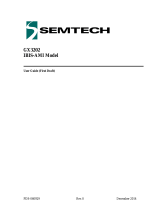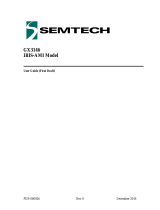Page is loading ...

GS3140
User Guide Rev.0
PDS-061005 May 2015
2 of 7
Semtech
Propietary & Confidential
www.semtech.com
1. Introduction
The GS3140 is a high-speed BiCMOS device designed to equalize and restore signals
received over cable. The device is designed to support SMPTE ST 424, SMPTE ST
292, SMPTE ST 259 and AES10 (MADI), and it is optimized for performance at 125Mb/s,
270Mb/s, 1.485Gb/s, and 2.97Gb/s. This document describes the contents, features, and
use of the GS3140 IBIS-AMI model. The model includes the cable equalizer's different
swing and de-emphasis settings and facilitates simulation of the cable equalizer in EDA
platforms compliant with IBIS 5.0.
2. GS3140 IBIS-AMI Model
The GS3140 IBIS-AMI model comprises Rx and Tx models. The Rx model slices the signal
received from a channel and retransmits it into the second channel using the Tx model.
Figure 2-1 shows the block diagram of a sample Testbench to simulate GS3140 IBIS-AMI
model.
Figure 2-1: Block Diagram of a Sample Testbench to Simulate the GS3140 IBIS AMI Model
2.1 GS3140 Receiver IBIS-AMI Model
The GS3140 Receiver IBIS-AMI model consists of three parts: (1) the Analog Termination
IBIS model, (2) the Receiver AMI model and (3) the QFN package model. The block
diagram in Figure 2-2 shows the sequence of signal flow and the individual parts of the
model. The external S-parameter file for the QFN Package model extends the accuracy
of the package effects beyond which can be described by R, L and C components in the
current IBIS 5.0 standard. The external S-parameter data is processed as part of the
channel by the EDA platforms.
Figure 2-2: GS3140 Receiver IBIS-AMI Model
RxTx
Rx Tx
Channel 1
Channel 2
Analog
Term
QFN Package
(S-parameters)
AMIFrom Channel
IBIS-AMI Model

GS3140
User Guide Rev.0
PDS-061005 May 2015
3 of 7
Semtech
Propietary & Confidential
www.semtech.com
2.1.1 GS3140 Receiver IBIS Model
The receiver IBIS model provides the characterized GS3140 Receiver input termination
which is used by the EDA platform to determine the time-domain impulse response for
the channel. The model is based on a single-ended non-inverting characterization of the
GS3140 Receiver and the EDA platform develops a differential model from
complimentary copies of the single-ended model. Note that the IBIS model only
contains the DC termination impedance of the receiver (I-V tables in IBIS file) and doing
frequency dependent simulations (e.g. return loss simulations) using the IBIS file is not
accurate. It is recommended to use “GS3140_RX_Term.s2p” S-parameter file instead of
the IBIS file in order to do input return loss (IRL) simulations.
2.1.2 GS3140 Receiver AMI Model
The GS3140 Receiver AMI model only includes the slicer. The adaptive equalizer and
Belden cable model are not included in the AMI model and the user should add the
deterministic jitter to their test-bench based on the Belden cable length that they are
using and GS3140 Data Sheet. For example, if the cable length is 180m and the data rate
is 2.97Gb/s, maximum output jitter is 0.4UI based on GS3140 Data Sheet. These values
should be added to the test-bench to have more accurate results.
2.1.3 GS3140 Receiver Package Model
The GS3140 QFN package model is provided as a 4-Port S-parameter file
(GS3140_RX_Pkg.s4p) in standard touchstone format from 0GHz to 30GHz with 3001
data points.
Note: The package model does not include the application circuit and an appropriate
application circuit must be used in the simulation Testbench along with the IBIS-AMI
model. A typical application circuit can be found in the GS3140 Data Sheet.
2.2 GS3140 Transmitter IBIS-AMI Model
The GS3140 Transmitter IBIS-AMI model consists of three parts: (1) the Analog Driver IBIS
model, (2) the Transmitter AMI model, and (3) the QFN package model. The block
diagram in Figure 2-3 shows the sequence of the signal flow and the individual parts of
the model.
Figure 2-3: GS3140 Transmitter IBIS-AMI Model
Analog
Ter m
QFN Package
(S-parameters)
AMI To Channel
IBIS-AMI Model

GS3140
User Guide Rev.0
PDS-061005 May 2015
4 of 7
Semtech
Propietary & Confidential
www.semtech.com
2.2.1 GS3140 Analog Driver IBIS Model
The Analog Driver IBIS model receives processed signal information from the
Transmitter AMI model and applies the analog characteristics of the GS3140 Transmit
driver. The model is based on a single-ended non-inverting characterization of the
GS3140 Transmitter and the EDA platform develops a differential model from
complimentary copies of the single-ended model. Note that the IBIS model only
contains I-V and V-T characteristics of the transmitter, and doing frequency dependent
simulations (e.g. return loss simulations) using the IBIS file is not accurate.
2.2.2 GS3140 Transmitter AMI Model
The GS3140 Transmitter AMI model consists of programmable swing and de-emphasis
settings which can be adjusted by model specific parameters. These parameters are
described below. Note that these parameters are the same as the registers in the Data
Sheet. It is highly recommended that the user read the GS3140 Data Sheet and its
register descriptions carefully before using the model.
1. Output_Swing: Sets the output swing level (amplitude) when the feature is
enabled.
Table 2-1: Output_ Swing in Transmitter AMI Model
Output_Swing Register Value Swing
0 0000
250mV
ppd
1 0001
300mV
ppd
2 0010
350mV
ppd
3 0011
400mV
ppd
4 0100
450mV
ppd
5 0101
500mV
ppd
6 0110
550mV
ppd
7 0111
600mV
ppd
8 1000
650mV
ppd
9 1001
700mV
ppd
10 1010
750mV
ppd
11 1011
800mV
ppd
(default)
12 1100
850mV
ppd
13 1101
900mV
ppd
14 1110
950mV
ppd
15 1111
1000mV
ppd

GS3140
User Guide Rev.0
PDS-061005 May 2015
5 of 7
Semtech
Propietary & Confidential
www.semtech.com
2. Output_Swing_En: Enables overriding of the default output swing with the
Output_Swing value.
3. DeEmphasis_Enable: Enables or disables output de-emphasis.
4. DeEmphasis_Delay: Selects de-emphasis delay.
5. DeEmphasis_Level: Selects de-emphasis level.
Table 2-2: Output_ Swing_En in Transmitter AMI Model
Output_Swing_En Swing
0
800mV
ppd
1 Set by Output_Swing parameter
Table 2-3: DeEmphasis_Enable in Transmitter AMI Model
DeEmphasis_Enable De-emphasis Setting
0 De-emphasis disabled
1 De-emphasis enabled
Table 2-4: DeEmphasis_Delay in Transmitter AMI Model
DeEmphasis_Delay De-emphasis Delay
0 100ps
1 200ps
Table 2-5: DeEmphasis_Level in Transmitter AMI Model
DeEmphasis_Level De-emphasis Level
0 0dB (de-emphasis off)
11.2dB
22.5dB
34.1dB
46.0dB
58.5dB
6 12.0dB
7 18.1dB

GS3140
User Guide Rev.0
PDS-061005 May 2015
6 of 7
Semtech
Propietary & Confidential
www.semtech.com
3. Correlation
In this section, the GS3140 IBIS-AMI model is compared with some post-layout
simulation results. The eye diagrams at the GS3140 output at HD and 3G data rates for
different FR4 trace lengths and de-emphasis settings are shown in Figure 3-1. The input
signal in these simulations is PRBS23.
Figure 3-1: Comparison of the Eye Diagrams from Cadence Simulation Results with
Simulations Using the GS3140 IBIS-AMI Model at HD and 3G Data Rates for
Different FR4 Trace Lengths and De-emphasis Settings

IMPORTANT NOTICE
Information relating to this product and the application or design described herein is believed to be reliable, however such information is
provided as a guide only and Semtech assumes no liability for any errors in this document, or for the application or design described herein.
Semtech reserves the right to make changes to the product or this document at any time without notice. Buyers should obtain the latest relevant
information before placing orders and should verify that such information is current and complete. Semtech warrants performance of its
products to the specifications applicable at the time of sale, and all sales are made in accordance with Semtech’s standard terms and conditions
of sale.
SEMTECH PRODUCTS ARE NOT DESIGNED, INTENDED, AUTHORIZED OR WARRANTED TO BE SUITABLE FOR USE IN LIFE-SUPPORT APPLICATIONS,
DEVICES OR SYSTEMS, OR IN NUCLEAR APPLICATIONS IN WHICH THE FAILURE COULD BE REASONABLY EXPECTED TO RESULT IN PERSONAL
INJURY, LOSS OF LIFE OR SEVERE PROPERTY OR ENVIRONMENTAL DAMAGE. INCLUSION OF SEMTECH PRODUCTS IN SUCH APPLICATIONS IS
UNDERSTOOD TO BE UNDERTAKEN SOLELY AT THE CUSTOMER’S OWN RISK. Should a customer purchase or use Semtech products for any such
unauthorized application, the customer shall indemnify and hold Semtech and its officers, employees, subsidiaries, affiliates, and distributors
harmless against all claims, costs damages and attorney fees which could arise.
The Semtech name and logo are registered trademarks of the Semtech Corporation. All other trademarks and trade names mentioned may be
marks and names of Semtech or their respective companies. Semtech reserves the right to make changes to, or discontinue any products
described in this document without further notice. Semtech makes no warranty, representation or guarantee, express or implied, regarding the
suitability of its products for any particular purpose. All rights reserved.
© Semtech 2015
GS3140
User Guide Rev.0
PDS-061005 May 2015
7 of 7
Semtech
7Propietary & Confidential
Contact Information
Semtech Corporation
200 Flynn Road, Camarillo, CA 93012
Phone: (805) 498-2111, Fax: (805) 498-3804
www.semtech.com
/












